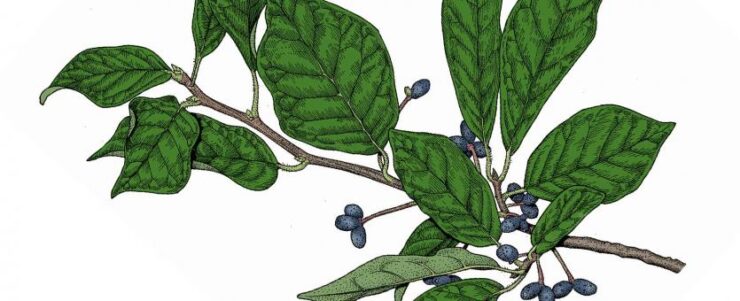- Blackgum – Nyssa sylvatica: A medium-sized tree whose branches stand at right angles to the trunk.
- Leaf: Alternate, simple, pinnately veined, obovate in shape with an entire margin, 3 to 5 inches long. Rarely toothed.
- Flower: Not showy, green-white in color, appearing with the leaves, hanging in clusters.
- Fruit: A dark, purplish-blue drupe, 1/2 inch long, with a fleshy coating surrounding a ribbed pit. Fruit is favored by Wood Ducks and many other birds but these trees just don’t put out very much fruit. But considering where they grow you take what you can get.

Use of Black Gum Plant
Timber and Lumber
It is widely used in the lumber industry to make pallets, crates, and railroad ties. The fine grain and texture also make it ideal for furniture and flooring. Its resilience under heavy use makes it perfect as timber. Lumberyards and construction companies prefer Black Gum as it is quite reliable.
Honey Production
Bees collect nectar from Black Gum flowers to create honey, which is valued for its unique flavor and light, golden color. Tupelo honey does not crystallize easily, increasing its market value.
Beekeepers rely on Black Gum trees to sustain honey production operations. This type of honey holds a premium price in the market due to its quality and unique properties.
Medicine
Native Americans used the inner bark to treat headaches and respiratory issues. The bark also served as an astringent and a remedy for dysentery.
Experts continue to explore the medicinal properties and its potential benefits.
Shade and Windbreaks
Black Gum trees provide effective shade and serve as windbreaks. Their dense foliage creates cool, shaded areas, which are beneficial in agricultural and residential settings.
The sturdy branches reduce wind speed, protecting crops and property. In urban areas, Black Gum trees enhance green spaces, making them more pleasant and functional. Their role in reducing heat and wind is valuable in creating comfortable environments for residents and workers.
Agricultural Benefits
Farmers benefit significantly from planting Black Gum trees. These trees provide shade for livestock, reducing heat stress and improving animal welfare. The dense foliage can also protect crops from wind damage.
Additionally, Black Gum trees contribute to soil health by adding organic matter through leaf litter. This organic matter enriches the soil, promoting better crop growth.
Urban Landscaping
In urban environments, Black Gum trees are valued for their ability to thrive in varied conditions. They are often planted as shade trees along streets and in parks. Their dense canopy provides relief from the heat, and their sturdy branches withstand urban stresses.
Black Gum trees also add aesthetic value with their attractive bark and colorful foliage. City planners and landscapers use these trees to enhance urban green spaces and improve the quality of life for residents. Their adaptability and resilience make them a practical choice for urban landscaping projects.
Conclusion
The Black Gum tree gives us strong, durable wood used for making things like pallets, crates, and furniture. It’s also key for producing tupelo honey, which has a unique flavor that people love. Historically, its bark was used to treat headaches and respiratory problems. The tree provides great shade and helps protect against wind, making it useful in different places.

